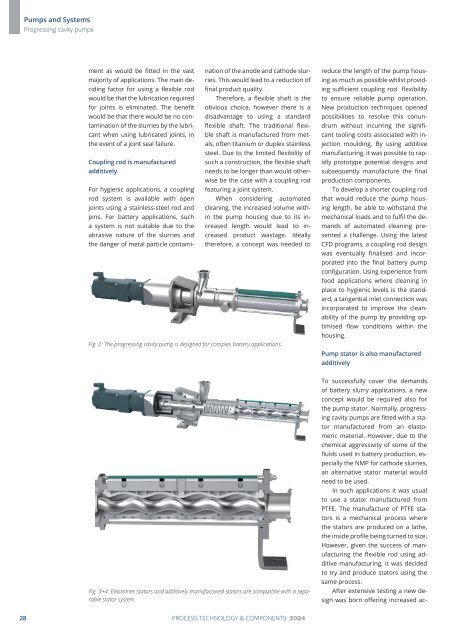PuK - Process Technology & Components 2024
A technical trade magazine with a history of more than 60 years.
A technical trade magazine with a history of more than 60 years.
Create successful ePaper yourself
Turn your PDF publications into a flip-book with our unique Google optimized e-Paper software.
Pumps and Systems<br />
Progressing cavity pumps<br />
ment as would be fitted in the vast<br />
majority of applications. The main deciding<br />
factor for using a flexible rod<br />
would be that the lubrication required<br />
for joints is eliminated. The benefit<br />
would be that there would be no contamination<br />
of the slurries by the lubricant<br />
when using lubricated joints, in<br />
the event of a joint seal failure.<br />
nation of the anode and cathode slurries.<br />
This would lead to a reduction of<br />
final product quality.<br />
Therefore, a flexible shaft is the<br />
obvious choice, however there is a<br />
disadvantage to using a standard<br />
flexible shaft. The traditional flexible<br />
shaft is manufactured from metals,<br />
often titanium or duplex stainless<br />
steel. Due to the limited flexibility of<br />
Coupling rod is manufactured<br />
additively<br />
such a construction, the flexible shaft<br />
needs to be longer than would otherwise<br />
be the case with a coupling rod<br />
For hygienic applications, a coupling featuring a joint system.<br />
rod system is available with open When considering automated<br />
joints using a stainless-steel rod and<br />
pins. For battery applications, such<br />
a system is not suitable due to the<br />
abrasive nature of the slurries and<br />
the danger of metal particle contami-<br />
cleaning, the increased volume within<br />
the pump housing due to its increased<br />
length would lead to increased<br />
product wastage. Ideally<br />
therefore, a concept was needed to<br />
Fig. 2: The progressing cavity pump is designed for complex battery applications.<br />
reduce the length of the pump housing<br />
as much as possible whilst providing<br />
sufficient coupling rod flexibility<br />
to ensure reliable pump operation.<br />
New production techniques opened<br />
possibilities to resolve this conundrum<br />
without incurring the significant<br />
tooling costs associated with injection<br />
moulding. By using additive<br />
manufacturing, it was possible to rapidly<br />
prototype potential designs and<br />
subsequently manufacture the final<br />
production components.<br />
To develop a shorter coupling rod<br />
that would reduce the pump housing<br />
length, be able to withstand the<br />
mechanical loads and to fulfil the demands<br />
of automated cleaning presented<br />
a challenge. Using the latest<br />
CFD programs, a coupling rod design<br />
was eventually finalised and incorporated<br />
into the final battery pump<br />
configuration. Using experience from<br />
food applications where cleaning in<br />
place to hygienic levels is the standard,<br />
a tangential inlet connection was<br />
incorporated to improve the cleanability<br />
of the pump by providing optimised<br />
flow conditions within the<br />
housing.<br />
Pump stator is also manufactured<br />
additively<br />
Fig. 3+4: Elastomer stators and additively manufactured stators are compatible with a separable<br />
stator system.<br />
To successfully cover the demands<br />
of battery slurry applications, a new<br />
concept would be required also for<br />
the pump stator. Normally, progressing<br />
cavity pumps are fitted with a stator<br />
manufactured from an elastomeric<br />
material. However, due to the<br />
chemical aggressivity of some of the<br />
fluids used in battery production, especially<br />
the NMP for cathode slurries,<br />
an alternative stator material would<br />
need to be used.<br />
In such applications it was usual<br />
to use a stator manufactured from<br />
PTFE. The manufacture of PTFE stators<br />
is a mechanical process where<br />
the stators are produced on a lathe,<br />
the inside profile being turned to size.<br />
However, given the success of manufacturing<br />
the flexible rod using additive<br />
manufacturing, it was decided<br />
to try and produce stators using the<br />
same process.<br />
After extensive testing a new design<br />
was born offering increased ac-<br />
28 PROCESS TECHNOLOGY & COMPONENTS <strong>2024</strong>

















